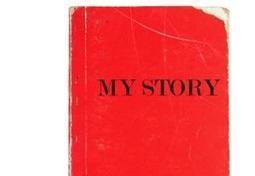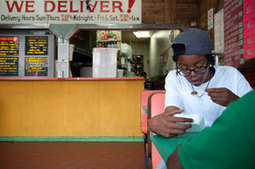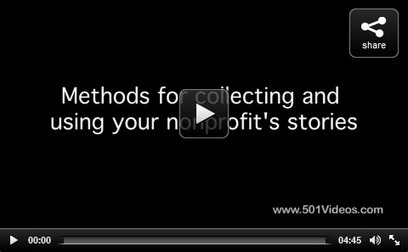"I am always interested in the science behind storytelling. What makes it such an effective part of our social being and communications?"
Get Started for FREE
Sign up with Facebook Sign up with X
I don't have a Facebook or a X account

 Your new post is loading... Your new post is loading...
 Your new post is loading... Your new post is loading...
At the beginning, G didn’t know what to say.
From
uxmag
"Storytelling has quickly become one of the most talked about topics in user experience and beyond—to the point that it’s almost cliché. Most of the ideas presented around storytelling are focused on simple reasons why storytelling is important and some marginal tips for telling a better story. The problem there is that we’re a step ahead of ourselves."
Whenever UX Magazine writes an article about storytelling I read it -- because they are usually sooooo good! And here's another one just for you.
UX Magazine is for geeks who are into User Experience design when developing software. UX design is all about using stories to create more user-friendly tech products. Way cool. I love working with engineers and how open they are to stories.
Anyway, this article is a must-read because it focuses our attention on where anyone working with stories needs to go first. As the author Sarah Doody says, "We’ve gone straight to how to tell the story of an experience or a product and skipped over the crucial element of why we’re telling these stories in the first place."
She continues: "But, if we truly want to make great experiences and products for people, we need to stop focusing on competing and start focusing on creating—creating products that are extensions of our own personal stories. . . you first must be the consumer. What you create must stem from your own personal story. You must live and breath for the experience, product, or business you are creating."
You tell 'em Sarah! She cites Steve Jobs, Jack Dorsey, and Mark Zuckerberg as examples of business leaders able to do this. And Sarah shares other stories to make her point.
She then poses a series of questions at the end of the article to help us focus on our 'why', our personal stories, and meeting the needs of customers.
And don't forget to read the comments at the end of Sarah's blog post. Along with the other article today from Thaler Pekar, we have a wealth of insights to make us story rich!
This review was written by Karen Dietz for her curated content on business storytelling at www.scoop.it/t/just-story-it ; [Great read and an interesting storytelling POV ~ Jeff] |
Using digital technology to tell stories can help charities with impact assessment, says Kieron Kirkland...
Using stories to evaluate results? Quantitatively??!! You bet!! Here is a fabulous article after my quantitative heart.
The author Kieron Kirkland talks about how the organization, Nominet Trust, worked with the org story company Cognitive Edge to capture stories and then have the story authors rank what their stories are about on a scale.
Once the story was captured, there were several types of scales the storytellers ranked their stories on -- generating big data!
See -- storytelling and evaluation can be done effectively if constructed properly.
This article goes hand-in-hand with newer qualitative evaluation processes for arts-based techniques (like storytelling) talked about in one of my favorite books, Method Meets Art; Arts-Based Research Practice by Patricia Leavy (2009).
If you struggle to connect stories about your projects to quantifiable results, then run to read this article.
Having helped organizations articulate measures so they can see progress, the first critical area to tackle are which measures are going to be used that are the most meaningful, given the project's objectives.
This article will give you several ideas for how to get started.
Enjoy!
This review was written by Karen Dietz for her curated content on business storytelling at www.scoop.it/t/just-story-it ; [A must-read for storytellers who need an ROI ~ Jeff]
"While not all agree, let's suppose, for a moment, that we are, in fact, presenting through our contemporary storytelling a relatively narrow range of the American experience. Some of the questions we ought to be asking are, is it enough to maintain the same formats, as we have, and try to entice more/different storytellers? Do we need to expand our awareness in some way to consider more broadly the particulars of this time, this particular space, and who is involved? And, fundamentally, what is it going to take to go further, to do more?"
Now here is a very thought-provoking piece about storytelling in general. I've curated it because the more businesses understand the craft of storytelling, the more effective we can be.
Warning -- there is such rich material here -- along with fabulous video examples to watch -- that you will need to carve out some time to explore everything here.
And hey -- we all live in a culture surrounded by media. It is important to keep up with shifts and changes in technology and its impact on storytelling so we can understand our daily life better -- and the opportunities open to us.
What is the biggest shift technolgy brings? Ethnographic storytelling. What the heck is that? It is when you put the camera and the storytelling into the hands of people to create and tell their story. Nothing new here -- this was pioneered by Anthropologists Sol Worth & John Adair in the 1972 book Through Navajo Eyes. The article contains several examples.
What is new is that now technology makes the ability to share our stories very easy and cheap to do -- through a proliferation of channels to share them. THAT is what is getting reinvented -- not the structure of a good story.
And technology is bringing us unique and very creative ways to craft our stories. For example, there's a link within this article to "How the Indie Audio Community Is Transforming Storytelling," This article shares a story where audio is dominant. It is great.
Other examples in the article include Localore -- a project about place-based storytelling.
What do I like about this article and the links to other articles within this piece? It asks essential questions like: Who gets to tell the story? Who gets to ask the question that begins the story? What is the question?
When businesses and organizations start asking themselves these questions FIRST when wanting to tell a digital story, they focus on the story first. Too many people in my experience -- when wanting to tell a digital story -- get caught up in the technology first and end up spending tons of money with unhappy results. Or they think the story will emerge if they just start talking - to be edited down by the videographer into a story -- with the same unhappy results.
So read this article, its links to other articles, explore the digital story examples given, and start figuring out the following: How can I have my customers share their stories about my organization using ethnographic storytelling? How can I leverage audio storytelling (see the article for info/examples) beyond radio & podcasts? How can I leverage location & physical space to share biz stories? How can I creatively use technology to share biz stories that reflect my/our Unique Voice & Unique Proposition?
I could comment at length on this article and its links. It has taken me awhile to curate this piece because I kept going back and dipping in for more.
So give yourself time to enjoy this creative romp exploring cutting edge electronic storytelling and all the deep insights here!
This review was written by Karen Dietz for her curated content on business storytelling at www.scoop.it/t/just-story-it ; [Karen's right. This is a rich vein of thinking about storytelling. ~ Jeff]
Storytelling can be an effective tool to engage donors or empower volunteers,but finding the right way to collect and capture stories can be a challenge. In the short video,“Methods for Collecting and Using your Nonprofit’s Stories,” Zan McColloch-Lussier from Mixtape Communications,offers some simple, practical tips to help non-profit communicators collect and share stories. I couldn't have said it better. Go watch this 4:45 min. video with quick tips for how to set up a story collection process within your organization. Doing so is what I call "sustainable storytelling" because you are embedding story collection and sharing within the daily work practices of your organization. Creating processes and systems like those shared in this video creates ongoing success with business and nonprofit storytelling. Otherwise, all that money you spent on a biz story workshop or new cool video becomes a mere one-off event -- like vaporware. I hope you get good ideas for your work/organization from watching this! |















It stimulates my curiosity.
Excellent video rescooped from Karen Dietz's site on Storytelling